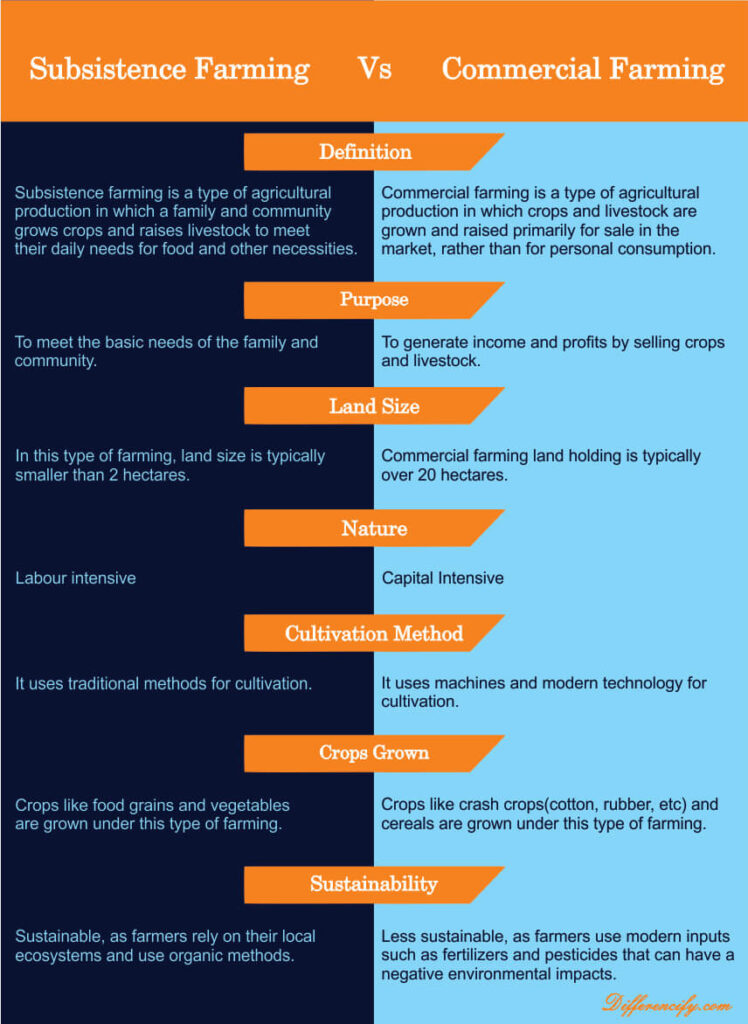Farming is the backbone of human civilization and has been practiced for thousands of years. In today’s world, farming is divided into two main categories: subsistence farming and commercial farming. While both types of farming involve growing crops and raising livestock, there are key differences between them. In this article, we will explore the differences between subsistence farming and commercial farming. So, let’s have a look at the table that compares both subsistence vs commercial farming in a sequential manner.
Subsistence Vs Commercial Farming
| Subsistence Farming | Commercial Farming |
|---|---|
| Subsistence farming is a type of agricultural production in which a family or community grows crops and raises livestock to meet their daily needs for food and other necessities. | Commercial farming is a type of agricultural production in which crops and livestock are grown and raised primarily for sale in the market, rather than for personal consumption. |
| The purpose of subsistence farming is to meet the basic needs of the family or community. | The purpose of commercial farming is to generate income and profits by selling crops and livestock. |
| In this type of farming, land size is typically smaller than 2 hectares. | Commercial farming land holding is typically over 20 hectares. |
| In subsistence farming, traditional and simple tools and techniques are used. | This type of farming uses advanced and modern equipment and techniques. |
| In this type of farming, a limited range of crops is grown, mainly for subsistence purposes. | In this type of farming, a wide range of crops is grown and selected for their profitability. |
| It is not market-oriented. | It is market-oriented, with crops and livestock sold to wholesalers or retailers. |
| It is labor-intensive in nature. | It is capital-intensive in nature. |
| Crops like food grains and vegetables are grown under this type of farming. | Crops like crash crops(cotton, rubber, etc) and cereals are grown |
| They are more sustainable, as farmers rely on their local ecosystems and use organic methods. | Commercial farming may be less sustainable as farmers use modern inputs such as fertilizers and pesticides that can have a negative environmental impact. |
| It has low risk, as the farmer produces only what is needed for subsistence. | It has high risk, as the farmer relies on market conditions and prices. |
You Can Also Read:
- Difference Between Intensive and Extensive Farming
- Difference Between Production and Productivity
- Difference Between Economic Growth and Development
What is Subsistence Farming?
Subsistence farming is a type of farming where farmers grow crops and raise animals to meet the needs of their families and communities. The primary objective of subsistence farming is to produce enough food to feed the family and ensure their survival. Subsistence farmers generally use traditional farming methods and techniques that have been passed down from generation to generation.
In subsistence farming, farmers often grow a wide variety of crops to ensure a diverse diet for their families. They also raise livestock such as cows, goats, and chickens for milk, eggs, and meat. The surplus produced from subsistence farming is often sold in local markets or used for trade.
What is Commercial Farming?
On the other hand, commercial farming is a type of farming where farmers grow crops and raise animals with the primary objective of making a profit. Commercial farmers use modern farming methods and techniques that are designed to increase crop yields and livestock productivity. They often specialize in one or two crops or animals that have high market demand and profitability.
In commercial farming, farmers use large-scale machinery, irrigation systems, fertilizers, and pesticides to maximize crop yields. They also invest in technology such as genetic engineering, hydroponics, and other modern farming techniques to improve crop and animal productivity.
Key Differences between Subsistence and Commercial Farming
While comparing subsistence vs commercial farming, here we have included some of the key differences between them. So let’s have a look at them.
- Objective – The primary objective of subsistence farming is to produce enough food to feed the family and ensure their survival. On the other hand, the primary objective of commercial farming is to make a profit by selling crops and livestock.
- Scale – Subsistence farming is generally practiced on a small scale, with farmers using traditional farming methods and techniques. Commercial farming, on the other hand, is practiced on a large scale, with farmers using modern farming methods and techniques.
- Technology – Subsistence farmers often use traditional farming methods such as hand tools, oxen, and simple irrigation systems. Commercial farmers, on the other hand, use modern technology such as tractors, combines, irrigation systems, and genetically modified crops to maximize crop yields and livestock productivity.
- Crop Diversity – Subsistence farmers often grow a wide variety of crops to ensure a diverse diet for their families. Commercial farmers, on the other hand, often specialize in one or two crops or animals that have high market demand and profitability.
- Market – Subsistence farmers often sell their surplus produce in local markets or use it for trade. Commercial farmers, on the other hand, sell their crops and livestock to national and international markets.
The following table also shows the complete difference between subsistence and commercial farming.

Conclusion
In conclusion, subsistence farming and commercial farming are two different types of farming with distinct objectives, scales, technologies, crop diversity, and markets. Subsistence farming is practiced on a small scale, with farmers using traditional farming methods and techniques to produce enough food to feed their families and ensure their survival. Commercial farming, on the other hand, is practiced on a large scale, with farmers using modern farming methods and techniques to make a profit by selling crops and livestock to national and international markets.
Reference Blog:



2 Comments